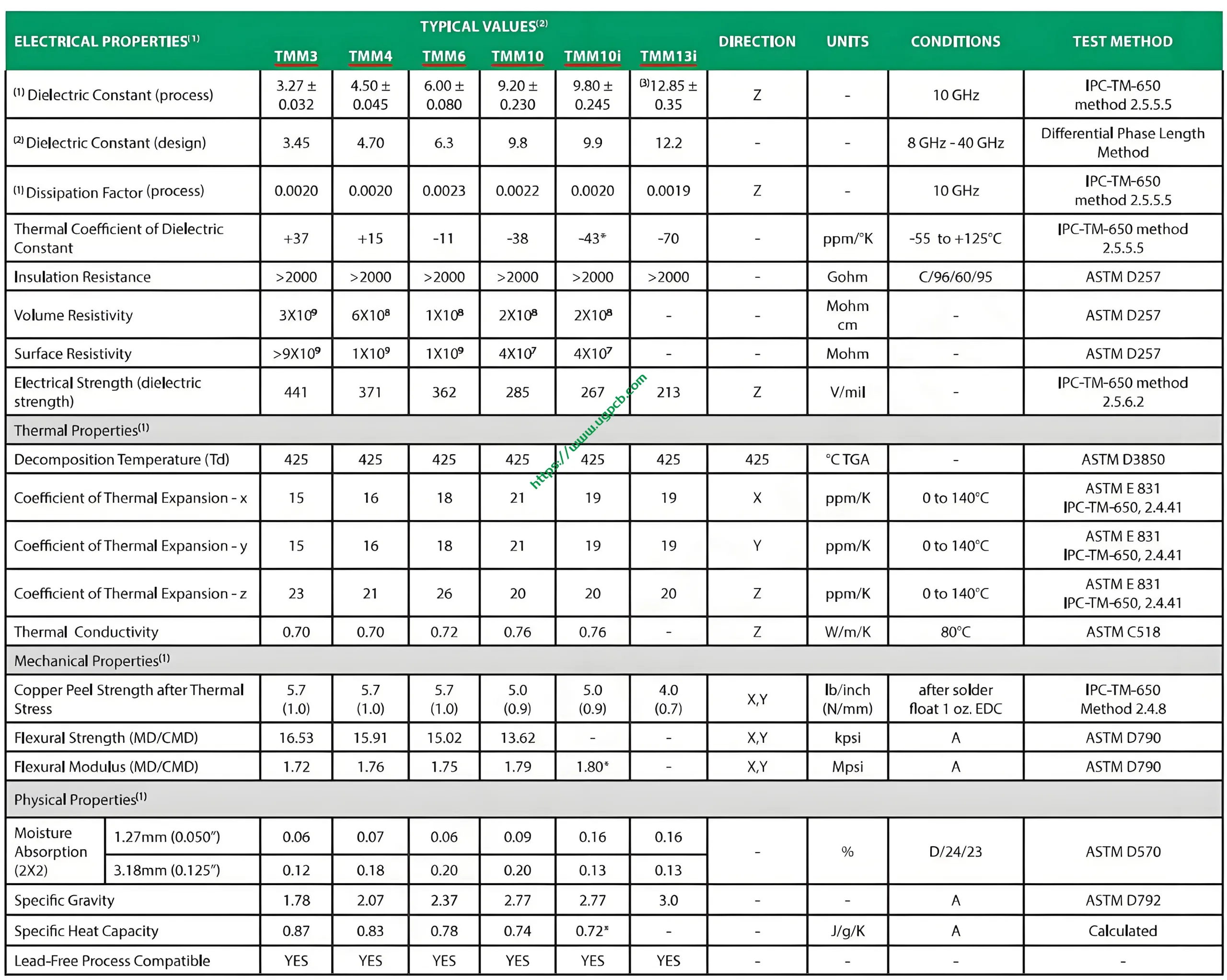Overview of Rogers TMM Thermosetting Microwave PCB Materials
Rogers TMM thermosetting microwave PCB materials combine a low dielectric constant thermal change rate, a thermal expansion coefficient consistent with copper foil, and a consistent dielectric constant. Due to their stable electrical and mechanical properties, TMM high-frequency PCB materials are ideal for high-reliability stripline and microstrip applications. Compared to alumina filler substrates, TMM laminates offer significant processing advantages, enabling larger specifications of copper clad and the use of standard PCB substrate processing procedures.
Range of Dielectric Constants and Thicknesses
TMM offers dielectric constants ranging from 3 à 13 and thicknesses from 0.015 à 0.500 pouces, with a tolerance of ±0.0015 inches.
TMM 13i Hydrocarbon Ceramic Isotropic Thermosetting Microwave Material
Spécifiquement, TMM 13i is a ceramic-filled thermosetting polymer designed for stripline and microstrip line applications requiring high through-hole reliability. Il a une constante diélectrique de 12.85 (±0.350) and is available in thicknesses from 0.015 à 0.500 pouces (±0.0015 inches).
Advantages of TMM Series Thermosetting Microwave Laminate
The TMM series thermosetting microwave laminate offers numerous advantages, y compris:
Electrical and Mechanical Properties
- Rich candidate dielectric constant
- Excellent mechanical properties
- Resistance to creep flow and cold flow
- Très faible taux de variation de la constante diélectrique avec la température
- Fit the thermal expansion coefficient of copper foil to ensure plated through-hole reliability
Chemical Resistance and Processing
- Resistant to chemical reagents, with no damage in production and placement processes
- Thermosetting resin ensures reliable wire bonding
- No special processing technology required
- TMM10 and 10i laminates can replace alumina substrates
- Passed RoHS certification, environmentally friendly
Typical Applications of TMM 13i Thermosetting Microwave Laminate
TMM 13i thermosetting microwave laminate is typically used in applications such as:
- RF and microwave circuits
- GPS antennas
- Power amplifiers and combiners
- Microstrip antennas
- Filters and couplers
- Dielectric polarizers and lenses
- Chip testing
Composition and Design of TMM Laminates
TMM thermosetting microwave materials are ceramic, hydrocarbon, and thermosetting polymer composite materials designed for high-reliability stripline and microstrip line applications with electroplated through-holes. They combine the advantages of ceramic laminates and traditional PTFE microwave circuit laminates without requiring specialized production technology. TMM laminates do not need sodium naphthoate treatment before electroless plating.
Electrical and Thermal Properties
TMM laminates have a very low dielectric constant thermal coefficient, typically less than 30 ppm/°C. Their isotropic coefficient of thermal expansion closely matches that of copper, enabling the production of highly reliable plated through holes and low etch shrinkage values. En plus, the thermal conductivity of TMM laminates is approximately twice that of traditional PTFE/ceramic laminates, benefiting heat dissipation.
Processing and Application of TMM Laminates
TMM laminates are based on thermosetting resins and do not soften when heated, allowing for wire bonding of component leads to circuit traces without concerns about pad lifting or substrate deformation. They can be used with electrodeposited copper foil ranging from 1/2 oz/ft² to 2 oz/ft², or directly bonded to brass or aluminum plates. The substrate thickness ranges from 0.015″ to 0.500″, and the substrate is resistant to corrosive agents and solvents used in printed circuit production. Donc, all commonly used PWB processes can be used to prepare TMM thermoset microwave materials.
Application in Space-Borne Equipment
For space-borne equipment, Rogers TMM series thermosetting microwave laminates are especially suitable. They are ceramic-filled thermosetting high molecular polymers that can provide a dielectric constant from 3 à 13 and a thickness range of 0.015 à 0.500 pouces, with a tolerance of ±0.0015 inches. TMM 3 hydrocarbon ceramic, with a design dielectric constant of 3.45, closely matches the required dielectric constant of 3.5 for space-borne applications. It can be selected to a thickness of 125 milles, avoiding the need for multiple layers or pressing and summing to achieve the required thickness. En plus, TMM3 microwave sheets exhibit minimal changes in dielectric constant with temperature variations in outer space, ensuring antenna performance stability. The X/Y/Z CTE of 15/15/23 matches the thermal expansion coefficient of copper foil, ensuring the stability and reliability of microstrip line/strip line performance.
 LOGO UGPCB
LOGO UGPCB




